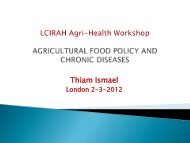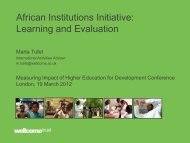Karen Lock and Marcus Keogh-Brown - London International ...
Karen Lock and Marcus Keogh-Brown - London International ...
Karen Lock and Marcus Keogh-Brown - London International ...
You also want an ePaper? Increase the reach of your titles
YUMPU automatically turns print PDFs into web optimized ePapers that Google loves.
The challenges of measuring<br />
health, agricultural <strong>and</strong> economic effects<br />
of adopting healthy diet<br />
recommendations:<br />
Brazil <strong>and</strong> the UK<br />
<strong>Karen</strong> <strong>Lock</strong> <strong>and</strong> <strong>Marcus</strong> <strong>Keogh</strong>-<strong>Brown</strong>,<br />
LSHTM <strong>and</strong> Leverhulme Centre for Integrative Research in<br />
Agriculture <strong>and</strong> Health (LCIRAH)
Authors<br />
• <strong>Karen</strong> <strong>Lock</strong>, LSHTM & LCIRAH<br />
• Richard D Smith, LSHTM & LCIRAH<br />
• Alan D Dangour, LSHTM & LCIRAH<br />
• <strong>Marcus</strong> <strong>Keogh</strong>-<strong>Brown</strong>, LSHTM & LCIRAH<br />
• Gessuir Pigatto, Universidade Estudial Paulista Julio de<br />
Mesquita Filho, Brazil<br />
• Corinna Hawkes, University of Sao Paulo, Brazil<br />
• Regina Mara Fisberg, University of Sao Paulo, Brazil<br />
• Zaid Chalabi, LSHTM & LCIRAH<br />
REF: <strong>Lock</strong> K, Smith RD, Dangour AD, <strong>Keogh</strong>-<strong>Brown</strong> M, Pigatto G,<br />
Hawkes C, Fisberg RM, Chalabi Z. Lancet. 2010 Nov<br />
13;376(9753):1699-709
Background <strong>and</strong> motivation<br />
• Transition to diets high in saturated fat/sugar/salt causing global<br />
public health concern in all world regions<br />
– food consumption major modifiable risk factor for chronic disease<br />
• Globalization of agri-food system profoundly affects production/<br />
distribution/consumption of these commodities<br />
• Traditional evaluation approaches consider population health OR<br />
agriculture OR wider economic effects of food policy<br />
AIM: to illustrate importance of inter-sectoral approaches to<br />
evaluating agri-food policy<br />
– Assessing health AND economic effects of adopting WHO<br />
‘healthy diet’ recommendations in different countries linked<br />
by agricultural trade
Case study approach<br />
• 2 countries linked by agricultural trade:<br />
– UK: high-income, predominantly food importing country, high<br />
rates of chronic disease<br />
– Brazil: middle-income, major agricultural producer <strong>and</strong> global<br />
exporter of food products including animal food products,<br />
population that is undergoing a rapid dietary <strong>and</strong> health<br />
transition<br />
• Study focuses on one aspect of a healthy diet:<br />
– Reduced saturated fat (SF) intake <strong>and</strong> the impact on ischaemic heart<br />
disease (IHD) risk<br />
– Applying WHO diet guidelines of SF intake
Assessing population health impacts<br />
of a ‘healthy diet’: methods<br />
• Potential impacts of dietary changes on IHD modeled<br />
using hazard ratios from recent meta‐analysis<br />
• Using the WHO comparative risk assessment method<br />
(used in global burden of disease study)<br />
• Assumed dietary change adopted by whole population<br />
immediately (i.e. no modelling of temporal transitional<br />
effects, effects on different age groups etc)<br />
• Health effects calculated relative to the baseline<br />
disease burdens from WHO projections for 2010
• UK:<br />
Population health impacts of<br />
adopting a ‘healthy diet’: results<br />
– reductions of 7% in Disability Adjusted Life Years<br />
(DALYs) <strong>and</strong> 3% of premature deaths averted in<br />
one year (equivalent to 3,270 deaths)<br />
• Brazil:<br />
– reductions of 3% of DALYs <strong>and</strong> 2% of premature<br />
deaths averted in one year (equivalent to 2,800<br />
deaths)
Limitations <strong>and</strong> assumptions: health<br />
model<br />
Model is simplistic (but likely to be conservative)<br />
• Limited to IHD (not diabetes, cancers etc)<br />
• Conducted only for adults<br />
• Brazil estimates based on Sao Paolo data<br />
– No national data, Sao Paulo largest city with comprehensive diet data taken<br />
as proxy. SP survey conducted in 2003 – may underestimate current<br />
consumption<br />
• Did not consider +ve health impacts of substitute foods i.e. fruits<br />
<strong>and</strong> vegetables<br />
• No allowance for difference in saturated fatty acids found in meat<br />
<strong>and</strong> dairy products<br />
• Assumed dietary change would be immediate, <strong>and</strong> in all<br />
population groups
Macro-economic impacts of a ‘healthy<br />
diet’: methods (1)<br />
We use Computable General Equilibrium (CGE) models<br />
How do CGE models work?<br />
1. System of equations to specify behaviours<br />
of various agents within the economy<br />
– Consumers decide what to consume <strong>and</strong> how much to<br />
save<br />
– Producers maximise profits<br />
– Government collects taxes, pays benefits<br />
2. Economic dataset of income/expenditure for a given year<br />
(must be balanced)<br />
3. Solved using computer algebra system to ‘force’ equilibrium<br />
solution
CGE Modelling Process<br />
Microconsistent benchmark data<br />
set for single year (SAM)<br />
Exogenous<br />
elasticities<br />
Calibration<br />
(model spec.)<br />
Calculation of<br />
benchmark equil.<br />
Replication<br />
check<br />
Policy evaluation - pairwise comparison<br />
between counterfactual & benchmark equil.
Macro-economic impacts of a<br />
‘healthy diet’: methods (2)<br />
• Scenarios designed to ‘Shock’ model to reflect the<br />
impact of healthier eating: reducing consumption of:<br />
– all animal source foods<br />
– meat only<br />
– dairy only<br />
• ‘Shocks’ impact upon model via:<br />
– labour supply (↑ due to ↓IHD mortality)<br />
– labour productivity (↑ due to ↓ IHD morbidity)<br />
– domestic consumption of agricultural products (↓)<br />
– imports/exports of agricultural products (↓)
CGE model scenarios<br />
• ‘Shock’ model by reducing intake of saturated fats<br />
to WHO guidelines (using 3 animal food strategies)<br />
– Overall SF reduction of 22% (UK), 7.4% (Brazil) equates to:<br />
• All animal source foods (ASF):<br />
• Meat only:<br />
• Dairy only:<br />
33% (UK), 10.5% (Brazil) or<br />
85% (UK), 18.2% (Brazil) or<br />
62% (UK), 27.6% (Brazil)<br />
• Mathematical modelling to estimate labour shocks<br />
– Mortality reduction 3.1% (UK), 2.0% (Brazil)<br />
– Morbidity reduction 4.4% (UK), 1.7% (Brazil)<br />
– 2008 sick certification for IHD <strong>and</strong> stroke used for baseline<br />
• 4 scenarios applied to the 3 animal food strategies: UK<br />
domestic dem<strong>and</strong>, Brazil domestic dem<strong>and</strong>, Brazil international<br />
(i.e. export) dem<strong>and</strong>, <strong>and</strong> Brazil domestic & international dem<strong>and</strong>
Percentage impact to GDP<br />
Economic impacts of a healthy diet:<br />
0.02<br />
0.01<br />
0<br />
-0.01<br />
-0.02<br />
-0.03<br />
-0.04<br />
-0.05<br />
-0.06<br />
-0.07<br />
-0.08<br />
UK<br />
Animal<br />
Domestic<br />
Brazil<br />
Animal<br />
Domestic<br />
Brazil<br />
Animal<br />
Int'l<br />
GDP Results<br />
Brazil<br />
Animal<br />
Dom &<br />
Int'l<br />
UK Meat<br />
Domestic<br />
Brazil<br />
Meat<br />
Domestic<br />
Brazil<br />
Meat Int'l<br />
• Overall UK losses greatest for dairy (£5.1bn) then meat<br />
(£3bn), ASF absorbed<br />
• Brazil losses greatest domestically for dairy (R$475m)<br />
but greatest international losses for meat (R$1.4bn)<br />
• Overall economic losses appear small, some small gains<br />
Brazil<br />
Meat<br />
Dom &<br />
Int'l<br />
UK Dairy<br />
Domestic<br />
Brazil<br />
Dairy<br />
Domestic<br />
Brazil<br />
Dairy Int'l<br />
Brazil<br />
Dairy<br />
Dom &<br />
Int'l
Percentage impact on GDP by sector<br />
Percentage impact on GDP by sector<br />
Grains/Crops<br />
Meat<br />
Animal<br />
Dairy<br />
Textiles<br />
Extraction<br />
Processed food<br />
Heavy manufacturing<br />
Light manufacturing<br />
Utils <strong>and</strong> construction<br />
Other transport<br />
Water transport<br />
Air transport<br />
Transp. & comms<br />
Other services<br />
Grains/Crops<br />
Meat<br />
Animal<br />
Dairy<br />
Textiles<br />
Extraction<br />
Processed food<br />
Heavy manufacturing<br />
Light manufacturing<br />
Utils <strong>and</strong> construction<br />
Other transport<br />
Water transport<br />
Air transport<br />
Transp. & comms<br />
Other services<br />
Percentage impact on GDP by sector<br />
Grains/Crops<br />
Meat<br />
Animal<br />
Dairy<br />
Textiles<br />
Extraction<br />
Processed food<br />
Heavy manufacturing<br />
Light manufacturing<br />
Utils <strong>and</strong> construction<br />
Other transport<br />
Water transport<br />
Air transport<br />
Transp. & comms<br />
Other services<br />
1.000<br />
0.000<br />
-1.000<br />
-2.000<br />
-3.000<br />
-4.000<br />
-5.000<br />
-6.000<br />
-7.000<br />
ASF<br />
Economic impacts<br />
by sector<br />
• Smaller impact for ASF<br />
• Intermediate ASF use by meat<br />
• Significant employment<br />
implications for meat/dairy<br />
Meat<br />
Dairy<br />
10.000<br />
5.000<br />
0.000<br />
-5.000<br />
-10.000<br />
-15.000<br />
-20.000<br />
-25.000<br />
-30.000<br />
-35.000<br />
5.000<br />
0.000<br />
-5.000<br />
-10.000<br />
-15.000<br />
-20.000<br />
-25.000<br />
-30.000<br />
-35.000<br />
UK Domestic<br />
Brazil Domestic<br />
Brazil <strong>International</strong><br />
Brazil Domestic <strong>and</strong><br />
<strong>International</strong>
Limitations <strong>and</strong> assumptions:<br />
economic model<br />
• Estimating long-term structural implications:<br />
– impact on exports to Brazil scaled back<br />
– what will substitute for the reduced production<br />
<strong>and</strong> consumption of meat <strong>and</strong> dairy products?<br />
• other foodstuffs, or other goods <strong>and</strong> services?<br />
• will substitutes represent an equivalent domestic,<br />
import <strong>and</strong> export profile?<br />
• No feedback loops<br />
– e.g where lost livelihoods are associated with<br />
negative health impacts
Study Conclusions<br />
Adopting a ‘healthy diet’ policy will affect both population<br />
health <strong>and</strong> the economy<br />
• Reductions in consumption of animal source foods in high<br />
consuming populations is of net benefit<br />
• Uneven distribution of benefits<br />
– UK : high health gains vs low economic losses<br />
– Brazil: low health gains vs high economic losses<br />
• Policy focused on reducing all animal source foods should create<br />
less economic impact<br />
• Ability of sectors to shift production (livestock to crops etc.) will<br />
influence economic impact<br />
• Health strategies tackling diet-related NCDs must address<br />
economic, social, environmental <strong>and</strong> health objectives
Conclusion<br />
• Underst<strong>and</strong>ing impacts on both health <strong>and</strong> wealth,<br />
<strong>and</strong> of winners <strong>and</strong> losers, critical to securing a<br />
sustainable food policy to maximise health benefits<br />
while minimizing risks<br />
• Although these analyses simplistic, highlighting<br />
health <strong>and</strong> economic affects together illustrates<br />
need to consider systems interactions between<br />
different policy sectors, <strong>and</strong> at different levels of<br />
impact (local to global) in developing upstream<br />
policies to tackle NCDs
Future challenges<br />
Good news - do not necessarily need new ‘metrics’<br />
• CGE now recommended tool by WHO<br />
• Already well accepted in environment, agriculture<br />
etc sectors<br />
Challenges:<br />
• Improving underst<strong>and</strong>ing of different method<br />
applications – promoting intersectoral applications<br />
• Improving data –<br />
– both data collection <strong>and</strong> compatibility between sources<br />
• Improving CGE methods<br />
– Sensitivity analysis<br />
– Refining of assumptions<br />
– Substitution for unhealthy goods – critical<br />
– Household split by SES<br />
– Trade modelling<br />
– Dynamic modelling
For info: what is a ‘healthy<br />
diet’?<br />
• WHO recommendations* for a ‘healthy diet’:<br />
– 15‐30% total energy as fat; saturated fat should be<br />
under 10% <strong>and</strong> trans fatty acids under 1%<br />
– 55‐75% total energy as total carbohydrate; added<br />
sugars should be under 10%<br />
– 10‐15% total energy as protein, mainly from plants<br />
– 400g/day of fruits <strong>and</strong> vegetables<br />
*WHO (2003). Diet, nutrition <strong>and</strong> the prevention of chronic diseases. Report of<br />
a Joint WHO/FAO Expert consultation. Technical Report 916: Geneva








